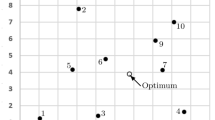Abstract
Around 1900 Wilhelm Launhardt [1] and Alfred Weber [2] invented the classical model of industrial location. Suppose that a firm produces one product, using two factors of production. The product has to be sold at a prelocated market place, and the input factors have to be bought at two likewise prelocated places where they are available. The three locations normally form the vertices of a triangle. Assuming that production requires fixed proportions of inputs to output, Weber could identify the problem of finding the best location for production with the problem of finding the location at which the sum of transportation costs is minimized.
Access this chapter
Tax calculation will be finalised at checkout
Purchases are for personal use only
Preview
Unable to display preview. Download preview PDF.
Similar content being viewed by others
References
W. Launhardt, “Die Bestimmung des zweckmässigsten Standorts einer Gewerblichen Anlage”, Zeitschrift des VereinsDeutscher Ingenieure 26:105–115(1882)
A. Weber öber den Standort der Industrien. Töbingen (1909)
M. J. Beckmann, Location Theory. Random House (1968)
T. F. Palander, Beiträge zur Standortstheorie. Uppsala (1935)
W. Isard, Location and Space-Economy. The M.I.T. Press (1956)
L. N. Moses, “Location and the theory of production”, Quarterly Journal of Economics 72:259–272(1958)
M. J. Beckmann and T. Puu, Spatial Structures. Springer-Verlag (1990)
M. J. Beckmann and T. Puu, Spatial Economics. North-Holland (1985)
Author information
Authors and Affiliations
Editor information
Editors and Affiliations
Rights and permissions
Copyright information
© 1998 Springer-Verlag Berlin · Heidelberg
About this chapter
Cite this chapter
Puu, T. (1998). Gradient Dynamics in Webrian Location Theory. In: Beckmann, M.J., Johannsson, B., Snickars, F., Thord, R. (eds) Knowledge and Networks in a Dynamic Economy. Springer, Berlin, Heidelberg. https://doi.org/10.1007/978-3-642-60318-1_12
Download citation
DOI: https://doi.org/10.1007/978-3-642-60318-1_12
Publisher Name: Springer, Berlin, Heidelberg
Print ISBN: 978-3-642-64350-7
Online ISBN: 978-3-642-60318-1
eBook Packages: Springer Book Archive




